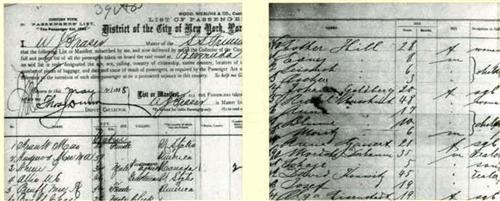Did your ancestors immigrate to the United States seemingly without a trace? Join the club. My aunt had fruitlessly scoured the Ellis Island passenger-lists database at <www.ellisisland.org> for her father-in-law. Perry Hjetland, a Norwegian emigrant who settled in Brown County, Kan. Then the subscription Web site Ancestry.com <Ancestry.com > launched its US Immigration Collection in November 2003, and we found a clue to Hjetland’s records within seconds.
With 80-plus databases containing more than 11 million names — and growing — this new resource probably holds information about your ancestors, too. Never before have so many immigration databases been available through just one Web subscription.
Of course, you already could access some of those databases — including the mammoth Passenger and Immigration Lists Index, 1500s-1900s — through subscriptions to Ancestry.com’s sister site Genealogy.com <www.genealogy.com>. (MyFamily.com owns both sites.) That site’s International & Passenger Records subscription — billed as the “most extensive collection of international and passenger records” — includes more than 22 million names spanning five centuries. The two collections reference many of the same records, but searching each collection for the same name can turn up different documents. And not all of the documents in the International & Passenger Records collection are immigration records, per se. So is the US Immigration Collection worth the subscription fee? Read on to find out.
What can you expect to find?
The jewel in the collection’s crown is the New York Passenger Lists, 1851-1891 index, which includes immigration records from Castle Garden <www.nps.gov/cacl>, Ellis Island’s predecessor. This database indexes all the Castle Garden records by name — a previously unaccomplished feat — making it possible to quickly find your link to the Old World.
The collection stretches beyond New York records, though. It delivers passenger lists from all major US ports, including Boston, Philadelphia, Baltimore and New Orleans. The information in each record varies, but generally contains the immigrant’s name, age, gender, the ship’s name, and ports and dates of departure and arrival. Some database entries even furnish images of original passenger lists, so you can verify the index details. Ancestry.com is adding new naturalization, alien, passport and border-crossing records daily.
If your ancestors arrived before 1820 — the year the federal government began collecting immigration records — you’ll want to search the Passenger and Immigration Lists Index, 1500s-1900s. Updated in 2003, it lists about 4.2 million people, 1.1 million of whom arrived between 1607 and 1819. You also might find your ancestor in one of the smaller, more-specialized databases such as Virginia Immigrants, 1623-1666; Ship Passenger Lists to the Carolinas; or American Emigrant Ministers, 1690-1811.
How do you search the collection?
Finding your ancestors can take just a few mouse clicks. From Ancestry.com’s home page, click on US Immigration Collection, and then search across all the databases. You can search by name (exact spelling or Soundex), age, keyword, ports of departure and arrival, date of arrival and ship name. Once you’ve entered your parameters, click the Search button. Within seconds, the site displays results with links to actual records, annotations and source bibliographies.
If your search returns zillions of records or practically zilch, a Refine Your Search box will appear, allowing you to add search parameters such as a state, country or keyword. You also can use “wildcards” to represent unknown letters in a word. If your ancestor’s name has multiple spellings, you might use a question mark: Sm?th, for example, will yield matches for Smith and Smyth. An asterisk can represent up to six letters. So for instance, Fran∗ will return matches for Fran, Franny, Frank and Frankie.
When looking for common surnames, refine your search as much as possible; otherwise, you’ll get oodles of useless hits. For example, a search for Smith turned up 75,356 individuals; Smith in Pennsylvania returned only 2,240. If you know your ancestor’s profession, you can narrow the search even further. When I added the word attorney to the Smiths-in-Pennsylvania search, the hits dropped to 27.
When I searched for Perry Hjetland, the results pointed me to a book titled Citizenship Records of Immigrants in Doniphan County. Kansas. Apparently, Hjetland had traveled to Doniphan County before settling in Brown. An annotation on the search-results page told me that the book contains “date and place of declaration of intent, or date and place of immigration. Birth date and place, physical characteristics, location of emigration, residence, family data and other information.” Not bad for a five-second search. Of course, my aunt will have to go to the library and find that book, but at least she now knows where to look.
How do you get copies of records?
If the database links to an image of your ancestor’s record, just print a copy from your computer screen. Otherwise, ask your local library to request the book or microfilm through interlibrary loan. If that’s not possible, post a message on a county mailing list (to find one, visit <lists.rootsweb.com>), and see if a fellow genealogist will go to her library and copy the reference material for you.
Should you subscribe?
Subscribers to Genealogy.com’s International & Passenger Records collection already have access to the Passenger and Immigration Lists Index as well as 40-plus other databases. But the US Immigration Collection indexes some records not found on Genealogy.com, and vice versa. To decide which collection(s) you should subscribe to, try searching each one. Without a subscription, you won’t be able to access the full database entries for your ancestors, but both sites will tell you how many times — and in what databases — your forebears appear.
Ancestry.com plans to add 14 million names to the US Immigration Collection by November. Should you wait to subscribe until all the records are online? This collection has a lot of potential to introduce you to your foreign roots. If it already holds references to your ancestors, I advise you to sign up now.
Subscriptions to the US Immigration Collection cost $19.95 per month or $79.95 per year. Current Ancestry.com subscribers can add an annual subscription to the collection for $39.95. Genealogy.com’s International & Passenger Records Collection runs $14.99 per month or $79.99 per year.



